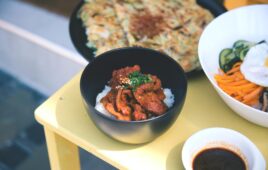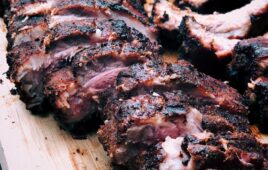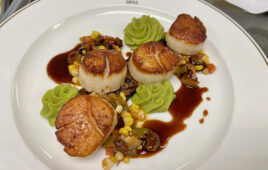
Comfort foods with a seafood focus—like this cioppino—are especially popular at Stonegate GC.
At the pandemic’s peak, members clung to the familiar, and comfort foods saw an unprecedented resurgence in popularity. While the definition of comfort food is subjective, mainly based on region or nostalgia, members reached for their own versions wherever they could find them.
Now, as members gather, clubs find themselves in a position where they must walk the line between menuing the foods members know and love and offering trendier dishes they might like to try.
At Stonegate Golf Club in Kissimmee, Fla., comfort foods equate to liver and onions, prime rib and fried catfish, says Executive Chef Nezzar Battle.
He and his staff make sure to always listen to members about what they want to eat, he says, and they pay close attention to buying patterns. Liver and onion, prime rib and fried catfish nights “always sell out.”
More squarely aligned with greater pandemic trends, pizza, too, has been hugely popular among Stonegate GC’s 5,000 members, says Battle, both by the slice and whole pies.
“Right now, I sell about 480 pizzas a day,” he says. “[In addition to our main menu], we have a display window where we feature specials. I encourage the staff come up with creative pizzas that they want to make.”
The club’s three restaurants include a bar and grill; a steak-and-seafood restaurant with rotating themes; and a bistro for made-from-scratch pizzas, plus salads and sandwiches.

Stonegate GC’s bourbon-flamed peach salad was a “a huge hit,” says Executive Chef Nezzar Battle, and is now a menu mainstay.
Other menu mainstays include a bourbon-flamed peach salad—an unexpected hit—as well as mahi-mahi and crab cakes, the latter inspired by Battle’s time in D.C. He’s originally from Jacksonville, Fla., and lives in Orlando now. But Battle spent time in Alaska, Colorado, and California and says he incorporates regional foods and lessons from each on his menus.
“I used to roll so much sushi in California,” he recalls. “Now we have a spicy tuna tartare that I can’t take off the menu.”

Stonegate GC’s spicy tuna tartare, a member favorite, was inspired by Executive Chef Nezzar Battle’s time in California.
Common Ground
At Coral Bay Club, a seasonal property with 600 members and two dining areas in Atlantic Beach, N.C., “any kind of fish dish” does well, says Executive Chef Genevieve Guthrie. Examples include fried shrimp, soft-shell crab bites, shrimp and grits, poke bowl, spicy tuna bowl, and zing-zing tacos, with battered shrimp tossed in a mild, slightly sweet sauce with Asian slaw and pico de gallo.
“We also do a pecan-dusted flounder meunière,” she says. “We pan-sear the flounder then top it with a lemon-wine-herb sauce and crab meat.”
Other staples include the sandbar salad—with shrimp, crab, mango, heart of palm, oranges, spiced pecans, coconut and a light citrus vinaigrette—and a summer salad with seared salmon, spinach, strawberries, blueberries, mango and oranges. It’s finished with a poppyseed citrus vinaigrette and spiced pecans.

Coral Bay’s Sandbar Salad features shrimp, crab, mango, heart of palm, oranges, spiced pecans, coconut and a light citrus vinaigrette.
Coral Bay Club’s members are relatively health-conscious, says Guthrie. Still, it’s a tricky balance, determining what to keep, add or 86 based on what members say they want versus what they order.
“We survey members at the end of the year,” Guthrie says, “and of course, they’re all saying, ‘healthy, healthy, healthy.’ But then they revert to fried shrimp and soft-shell crab. We do our best to find common ground.”
The other challenge, she notes, is keeping menus fresh without overwhelming operations.
“Our season is mainly from Memorial Day to Labor Day,” she says. “Historically, we changed the menu monthly, but that made it hard to train staff—especially with ongoing labor challenges. Now we change [the menu] around the Fourth of July. But we still offer features and a fresh catch daily.”
A More Educated Consumer
While Coral Bay Club’s membership is “pretty open to trying new and innovative concepts,” says Guthrie, chef’s tables allow her and her staff to shine, on- and off-season.
Members who come to a chef’s table event are more adventurous, as they don’t know what the menu will be, she notes. “They come in for the experience.”
Milwaukee (Wisc.) Athletic Club’s Executive Chef, Tom McGinty, agrees that members and guests are eager for new, in-person experiences, and they’re more educated about what they eat than ever before. This puts club chefs in a challenging but exciting position.
“We have to make sure we’re aware of what’s happening from a trend perspective so we can create dishes that are compelling,” he says.
The 140-year-old club, with 850 members, reopened this year following a $62 million renovation. It now features a rooftop restaurant that’s open seven days a week for breakfast, lunch and dinner, plus another restaurant that’s yet to open but will feature additional daily lunch offerings and a Friday night fish fry.
Upon reopening, the club stuck with some of its greatest hits, McGinty says, while gradually introducing new flavors and ingredients. The goal was to blend trending dishes with more familiar ones to reinvigorate menus.
“Comfort food is evolving and becoming a bit more sophisticated,” he says. “We do a salmon dish, but we serve it with ancient grains, including sorghum berry.”
A new comfort-focused summer hummus dish at the club features sweet potato, tahini and za’atar spice. And the oyster mushroom shawarma—made with crispy oyster mushrooms seasoned with a shawarma spice—features a tzatziki sauce made with coconut yogurt, so it’s vegan-friendly.
On its winter menu, Milwaukee Athletic Club serves macaroni and cheese with “a more artisanal approach,” McGinty says, made using taleggio and brie instead of cheddar and American.
“Members are always going to order mac and cheese,” he says, “but if you can offer them something a little bit different within the familiar, it’s a win for everyone.”




